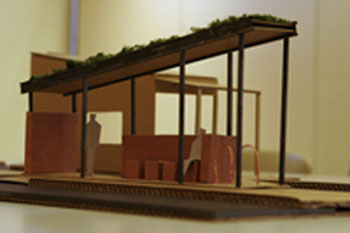 |
The conceptual model for the bus shelter, complete with cutout people.
|
 SLIDESHOW: SLIDESHOW:
|
Hear Churchill talk about the project |
|
A group of Architecture students at the University of Oregon called Design Bridge has seized the opportunity to design a bus shelter for SeQuential’s biofuel station on nearby McVey Highway that would be “a showcase of green design,” as the student group's coordinator, Erik Churchill, put it.
The students' design features two types of green building; a “living” roof and “rammed earth.” A living roof has a membrane that holds a thin layer of soil that’s used to grow plants on the roof itself. Rammed earth is a super-compacted mixture of clay and sand that can be used instead of concrete for structural purposes.
“We asked them questions to evoke some ideas of what they envisioned for the site and what, if any, restrictions there were,” said Lucas Gray, a member of Design Bridge. “Luckily the clients were very open-ended in their requests and really gave us the freedom to choose our own path.”
Ian Hill, SeQuential’s co-founder and managing partner, said the students’ design for the bus shelter was in tune with SeQuential’s ideals of sustainability and “truth in materials.” He also said working with Design Bridge has been a new and exciting process.
“It’s another way to differentiate ourselves as a company,” he said. “We’re not just throwing up pre-fab whatever; we’re really paying attention to the materials and how they got there.”
Gray said rammed earth is far more eco-friendly than concrete because it can be found locally and, unlike concrete, can be easily returned to the earth.
“Concrete tends to come from strip mining, basically going along and totally destroying a mountain landscape,” he said. “It is destined for a landfill after its first use has ended.”
Rammed earth, in contrast, is “a very low-tech material,” Gray said. It can be made manually using a heavy weight on the end of a pole, which makes it ideal because it avoids the use of machinery that burns fossil fuels, and it can be used in developing countries where that machinery may not be available.
The students are planning to rent hydraulic “tampers” to compact the rammed earth, Gray said. “But we are also looking into renting the EWEB (Eugene Water and Electric Board) portable solar energy supply truck to power these tools in a more sustainable way than plugging into the standard energy grid.”
The living roof featured in the design would be built to match the one already at the McVey station, according to Gray. It would use a recycled steel structure resting on rammed earth walls.
Erik Churchill said a living roof would not only convert carbon dioxide into
oxygen but also would prevent the “urban heat-island effect.”
Perhaps most important, it would reduce runoff, which often leads
to fuel ending up in the river. At the McVey station, the living
roof would work in conjunction with the existing bio-swale to prevent
such harmful runoff. Churchill described the bio-swale as a man-made
marsh that absorbs contaminated rainwater.
Churchill said the actual construction of the bus shelter would take place in either the spring or the summer.
“I can’t wait,” he said. | 



